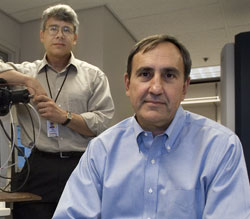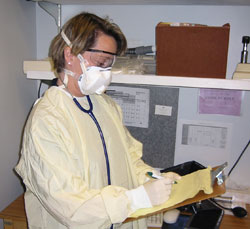People versus Microbes
Defenses sought for bio-terrorism and emerging infectious diseases
Throughout history, deadly infections have appeared and spread. Bacteria, viruses, and other microbes are abundant, protean life forms that adapt to hostile environments and attempt to overcome the body's defenses. Legionnaire's disease, HIV, West Nile virus, Ebola, Hantavirus, hepatitis C, prions, and SARS are recent examples of the regular emergence of pathogens.

Researchers are seeking new ways of detecting, preventing, and treating Gram-negative bacterial infections.
As Dr. Samuel Miller, an infectious diseases specialist and UW professor of medicine, microbiology and genome sciences pointed out, many societal changes can open gateways for new diseases. War, famine, displacement, and poor sanitation are often accompanied by pestilence. Certain conditions also make it easier for diseases to jump from birds, insects, and wild animals to people, pets and livestock. Changes in human behavior can create opportunities for rare diseases to become more common. Globalization and consolidation of food processing plants also increase the chances of worldwide outbreaks of food-borne diseases. In short, outbreaks of previously unknown, contagious diseases are nothing new. Neither are attempts to transform infectious disease agents into biological weapons.
What has changed is the approach to seeking countermeasures to infectious diseases, both those arising naturally and those dispersed intentionally. At the multi-site WWAMI Research Center of Excellence in Biodefense and Emerging Infectious Diseases (WWAMI RCE), directed by Miller, scientists are using advances in genomics, protein studies, cellular biology, and immunology to improve the identification, diagnosis, prevention, and treatment of infections.
 |
Dr. Samuel Miller, (foreground) director of the WWAMI Center for Biodefense and Emerging Diseases, and Dr. John Kemner, (background) assistant director, use spectrographic equipment which helps identify pathogens. |
Miller's specialty is the biology of Gram-negative bacteria. His work examines such questions as how disease-causing bacteria sense and invade cells, adjust to their new location, remodel their own surfaces, and alter cellular signaling processes. He is joined by Associate Director Dr. Walter Stamm, professor of medicine and head of the Division of Allergy
and Infectious Disease. Stamm is known for his work on chlamydial infections, genitourinary infections, and antimicrobial resistance. Rounding off this group is Assistant Director Dr. John Kemner, a microbiologist who studies interactions between pathogens and host cells.
The WWAMI RCE is one of eight across the country funded by The National Institute of Allergy and Infectious Diseases as part of heightened homeland security. The impetus for the centers was twofold: first, there was the recognition that biodefense preparedness is essential to national security; second, as is demonstrated by newly discovered diseases such as SARS, naturally emerging pathogens can have potentially devastating effects on public health, and far reaching effects on the global economy through consequent trade and travel restrictions. The centers will be focal points for research dedicated to understanding both existing and potential threats to public health. The centers will follow strict safety and security protocols and will not do weapons-development research.
Part of their mission is to serve as an information resource and link in the public health response system, particularly in the event of an outbreak. Should such an event occur, whether naturally or via a terrorist act , the biodefense centers would contribute their research expertise and infrastructure to efforts to identify and define relevant pathogens, and then to devise appropriate screening tests and treatment options. The federal government has introduced legislation under the moniker "Bioshield" to further improve response time to such events. To facilitate interactions between the research and response sectors, Center staff will meet regularly with public health officials to prepare interagency communication plans and coordinated approaches to be activated in the event of a local, national, or international health emergency.
Further mandates of the RCEs include recruiting new researchers to the field and serving as key links in the dispersal of information to public health officials. The WWAMI RCE is incorporated into the WWAMI network of five states: Washington, Wyoming, Alaska, Montana, and Idaho. As such, it benefits from the long-term relationships among numerous medical and educational institutions over a broad portion of the country. These relationships are reciprocal in that they greatly enhance the Center's capacity to contribute its capabilities both for preparedness efforts and for times of acute need.
The WWAMI RCE builds on established expertise in several areas, particularly the UW's internationally recognized strengths as an infectious diseases research institution. The overall research environment at the UW and the wide range of expertise of its faculty contributed to the awarding of the grant, and will play no small part in its future success. The initial scientific goals of the Center include a better understanding of bacterial genome diversity, virulence genes, cell membranes, and bacterial proteins. Because the likely pathology of potential biological warfare agents and emerging infectious diseases would include airway irritation and pneumonia-like symptoms, several UW experts on respiratory physiology and lung disorders are participating in the Center's research. Of particular interest to these investigators is the question of how gram-negative bacteria lipopolysacchrides (specific cell wall structures) induce host cells to produce chemical signals that result in lung inflammation.
 |
| A UW Hall Health Center nurse wears protective attire for examining walk-in patients with potentially serious respiratory diseases. |
Other researchers will be looking at virulence factors present in lymph nodes and at variations in people's innate immunity to infection. Another group will work towards developing vaccines. Other projects will examine gram-negative bacteria that cause enteric and urinary system infections and meningitis, including those frequently implicated in hospital-acquired infections and those particularly dangerous to immune-suppressed patients, such as organ transplant recipients and individuals with AIDS or cancer. The Center's bioinformatics component will further integrate the immense amounts of data generated by project researchers and will help distribute that information to the nationwide network of investigators working on similar scientific problems.
The initial organisms targeted for study at the WWAMI RCE are Yersinia pestis, the flea-borne pathogen responsible for plague; Francisella tularensis, the cause of tularemia, a lung and gastrointestinal disorder which is spread by ticks, as well as by rabbits and other wild game; and Burkholderia pseudomallei, an infectious pathogen found in contaminated water and soil (usually in the tropics). It is the agent of melidiosis, a skin, lung, or blood infection.
Miller commented: "These bacteria are similar in the sense that respiratory effects are the most serious complication of infection. If an infected person doesn't develop pneumonia, these infectious are not terribly lethal and usually can be treated. However, if pneumonia occurs, these infections can be fatal even with treatment."
 |
| Many events attracting large numbers of attendees, such as the Western Washington Fair in Puyallup, have set up hand-washing stations to prevent the spread of disease. |
The first phase of the WWAMI RCEs overall research plan will concentrate intensively on basic research. Data acquisition will be complemented by preliminary investigation of host cell models and human responses, as well as by preclinical testing of the most obvious vaccine and therapeutic candidates. In phase two, these latter efforts will intensify, while data acquisition efforts will expand to include studies of new organisms of relevance to biodefense and emerging infectious diseases. Phase three will look towards increased collaborations with national agencies and private industries to translate RCE basic research into viable therapeutic products, such as vaccines and new antibiotics.
As Dr. Miller said, "The world will always have infectious diseases as a problem. However, we are responding as a country to maintain research and development that could make a big difference to people. We anticipate these centers will produce important knowledge, but we can't predict how long discoveries will take. Will we need patience or be lucky? The resources committed to these centers will likely bring us opportunities to move rapidly ahead."
In addition to its UW School of Medicine location, the WWAMI Regional Center for Excellence has sites at the Veteran's Affairs Puget Sound Health Care System, Harborview Medical Center, Children's Hospital Regional Medical Center, the Institute for Systems Biology in Seattle, the National Institute of Allergy and Infectious Diseases Rocky Mountain Laboratories in Hamilton, Mont., and the Washington and Oregon National Primate Research Centers. The center hopes to expand to other public university and Veteran's Affairs sites in Montana, eastern Washington, Idaho, Boise, Oregon, and Alaska.
